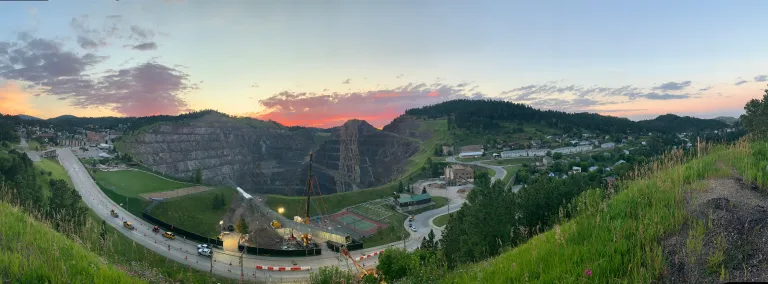Crews install LBNF conveyor system above US-85
Conveyor is the “most visible” milestone for Long-Baseline Neutrino Facility pre-excavation work
The most publicly visible milestone of the Long-Baseline Neutrino Facility’s (LBNF) pre-excavation work, a conveyor system, now extends over U.S. Highway 85 in Lead, South Dakota.
“It’s the most visible, but far from the only work that has been happening over the past year to support the Long-Baseline Neutrino Facility,” said Christopher Mossey, Fermi National Accelerator Laboratory (Fermilab) Deputy Director for the LBNF/DUNE-US Project.
Installation of the conveyor is one of a series of infrastructure strengthening projects undertaken to prepare the Sanford Underground Research Facility (Sanford Lab) for its role as LBNF’s Far Site. Such projects lay the groundwork for the Deep Underground Neutrino Experiment (DUNE), the most ambitious particle physics experiment on U.S. soil, hosted by the Department of Energy’s Fermilab.
“The LBNF project is making wonderful progress sitewide at Sanford Lab, and it’s great to see this visible example of the team’s hard work now safely in place,” said Mike Headley, executive director of Sanford Lab.
Supporting excavation
Almost a mile underground, on the 4850 Level of Sanford Lab, massive caverns must be excavated to house DUNE’s Far Detector. This will require the excavation of approximately 800,000 tons of rock, and the conveyor system will be instrumental in the removal of this rock.
Once excavated, the rock is hoisted up the Ross Shaft, where it will be crushed in the Ross crusher and deposited onto the conveyor system. The first section of the conveyor system will transport rock from the Ross crusher through the tramway, a half-mile tunnel that was used by Homestake Mining Company (Homestake) to transport ore near the end of the twentieth century. The second segment carries the rock from the tramway, down a hill, over the highway and into the Open Cut, an open pit mining area excavated by Homestake in the 1980s.
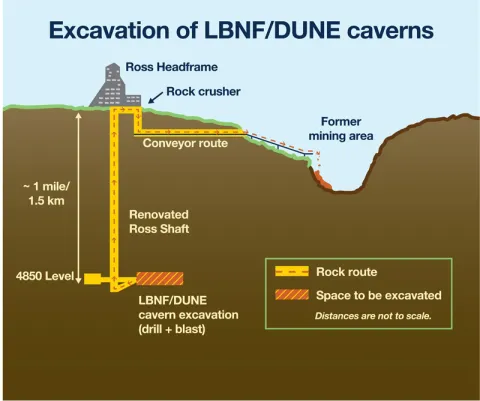
“The conveyor truss across US-85 marks the end of the one-and-three-quarter-mile journey that excavated rock will take as the caverns are excavated to support DUNE,” Mossey said.
Emulating Lead’s history
The conveyor structure will seem familiar to those who lived in Lead in the 1980s. In 1986, Homestake built a conveyor over U.S. Highway 85 to carry ore from the Open Cut Crushing Plant to a stockpile and reclamation system near the South Mill. The conveyor transported an estimated 12.37 million tons of crushed ore before it was shut down in 1998, then dismantled in 2001 and 2002.
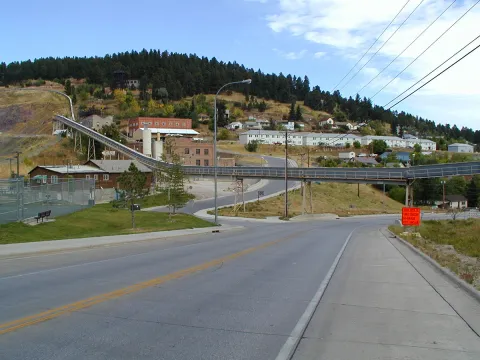
During the design stage of the contemporary conveyor, LBNF engineers consulted the City of Lead’s Historic Preservation Commission to create a design that was “respectful to the history of Lead,” said Joshua Willhite, Fermilab LBNF Far-Site Conventional Facilities Manager. As a result, the design includes elements that resemble Homestake’s original structure.
Constructing the conveyor
Kiewit-Alberici Joint Venture (KAJV), the contractor for the LBNF pre-excavation work, began work on the conveyor system in late 2019. To support the system, crews rehabilitated the tramway, modified the berm of the Open Cut and installed structural support bents, or frames.
This summer, crews began installing the steel truss structure, which will house the conveyor system. In late July, tourists and locals alike watched from a distance as a 200-foot crane deftly lifted truss segments and placed them atop structural support bents. After a concerted effort to install the truss over the highway, crews are now working to complete the rest of the 4,216-foot conveyor.
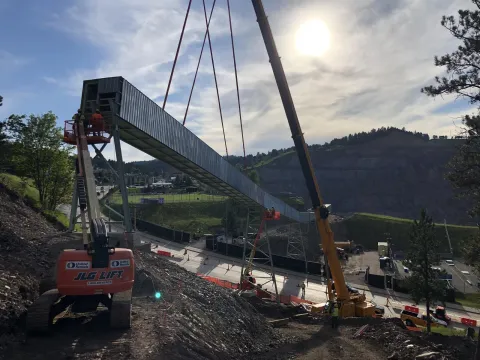
One step closer to DUNE
Initial blasting for LBNF-DUNE has already begun underground on the 3650 Level, as crews work to increase ventilation to the 4850 Level worksite. Soon, crews will begin blasting on the 4850 Level.
“This initial blasting will generate the rock we will use to commission the rock handling system,” Willhite said. “That will further prepare us for the start of the large excavation.”
During excavation, expected to take three years, workers will blast and drill to remove 800,000 tons of rock to make a home for the gigantic detector and its support systems. During excavation, the conveyor system will run about 10 hours each day, transporting between 1,500 and 2,500 tons of rock daily.
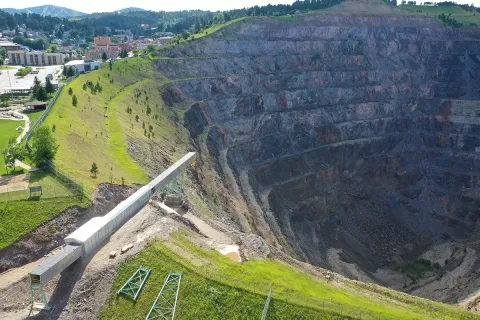
Safety comes first
During this project, the safety and health of the crews and community has remained a steadfast priority.
“In performing this work, it is clear that safety is the number one priority,” Willhite said, noting that KAJV delayed installation of the final over-the-highway conveyor segment to ensure that the crane could be operated safely. “And that's just one of many examples where KAJV was focused on the safety of their employees and the community.”
Sanford Lab is operated by the South Dakota Science and Technology Authority (SDSTA) with funding from the Department of Energy. Our mission is to advance compelling underground, multidisciplinary research in a safe work environment and to inspire and educate through science, technology, and engineering. Visit Sanford Lab at www.SanfordLab.org.
Fermilab is America’s premier national laboratory for particle physics and accelerator research. A U.S. Department of Energy Office of Science laboratory, Fermilab is located near Chicago, Illinois, and operated under contract by the Fermi Research Alliance LLC, a joint partnership between the University of Chicago and the Universities Research Association Inc. Visit Fermilab’s website at www.fnal.gov.
The Office of Science of the U.S. Department of Energy is the single largest supporter of basic research in the physical sciences in the United States and is working to address some of the most pressing challenges of our time. For more information, please visit energy.gov/science.
A special thank you to Steven Mitchell and his text Nuggets to Neutrinos, for providing information about and photos of Homestake Mining Company’s conveyance in Lead, South Dakota.
